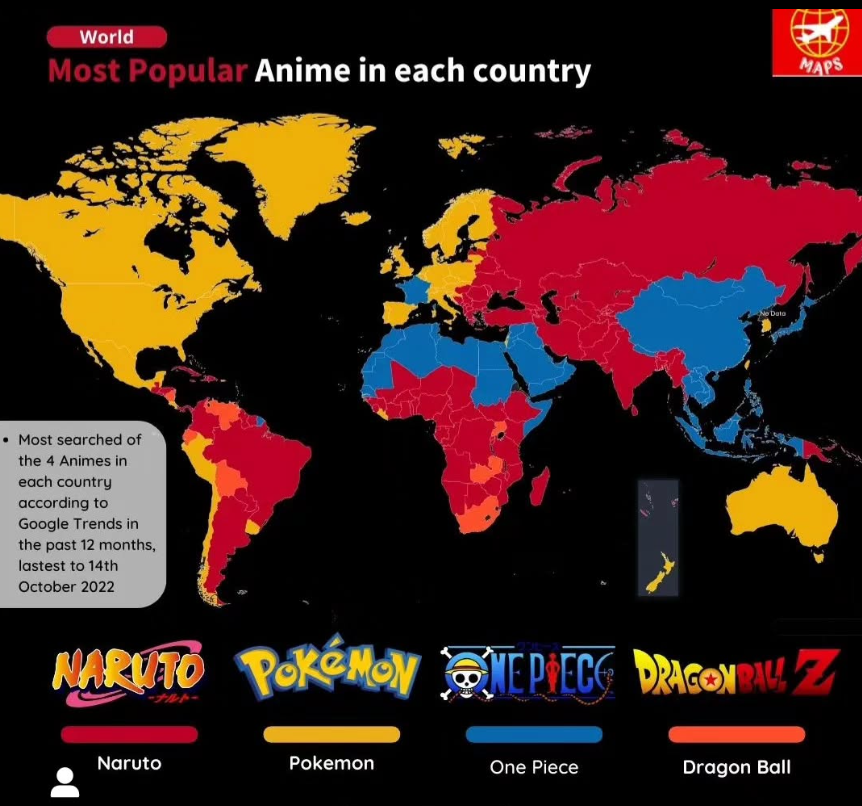Most Popular Anime by Country Map


Alex Cartwright
Senior Cartographer & GIS Specialist
Alex Cartwright is a renowned cartographer and geographic information systems specialist with over 15 years of experience in spatial analysis and data...
Geographic Analysis
What This Map Shows
The "Most Popular Anime by Country Map" provides an intriguing overview of anime preferences across various nations. Each country is represented by its most beloved anime, revealing not only the diversity of tastes but also how cultural exchanges shape entertainment. This visualization highlights the global phenomenon of anime, which has transcended geographical boundaries to capture the hearts of millions.
Anime, a style of animation that originated in Japan, encompasses a wide variety of genres and themes, appealing to diverse audiences worldwide. Have you ever wondered why certain anime resonate more in some countries than in others? This map helps shed light on those preferences, illustrating not just popularity but also cultural connections.
Deep Dive into Anime Popularity
Anime has grown from a niche interest into a global industry, with millions of fans engaging with series, films, and manga. The factors influencing anime popularity are multifaceted, ranging from cultural relatability and shared values to marketing strategies and availability on streaming platforms. In countries such as the United States, anime like "Naruto" and "My Hero Academia" have gained significant traction, partly due to their strong themes of friendship, perseverance, and heroism, which resonate broadly with American audiences.
Interestingly, the rise of streaming services like Crunchyroll and Netflix has revolutionized how anime is consumed globally. These platforms have made it easier for viewers to access a wide range of titles, thus broadening the audience base. Moreover, social media platforms allow fans to share their interests, discuss episodes, and promote shows, contributing to rising popularity in regions that previously had limited exposure to anime.
In Asia, countries such as South Korea and the Philippines have their own unique favorites, reflecting local tastes and cultural nuances. For example, in South Korea, titles like "Attack on Titan" are particularly popular, likely due to their intense storytelling and complex characters, which parallel some aspects of Korean drama. In the Philippines, series like "Doraemon" have been beloved for generations, showcasing a more nostalgic connection to childhood for many viewers.
Moreover, the diversity of genres in anime—from shonen (targeted toward young males) to shojo (targeted toward young females) and beyond—ensures that there is something for everyone. In countries with large youth populations, such as India, anime like "One Piece" and "Dragon Ball Z" have found a strong foothold, often being associated with the burgeoning youth culture that values entertainment that is both engaging and aspirational.
Regional Analysis
When examining the map regionally, distinct patterns emerge. In North America, the dominance of action-adventure and fantasy genres is evident, with titles like "Demon Slayer" and "Sword Art Online" leading the popularity charts. Conversely, in Europe, preferences can vary significantly. For instance, in France, where anime has a long-standing history, series like "One Piece" and "Death Note" have a massive following, reflecting the country’s appreciation for both classic and contemporary anime.
In Africa, anime viewership is on the rise, particularly in countries like Nigeria, where local adaptations and dubbed versions of popular series have helped bridge cultural gaps. This trend poses exciting opportunities for growth in the anime market across the continent. Meanwhile, in Latin America, anime has seen a tremendous surge, with shows like "Attack on Titan" and "Dragon Ball Super" gaining popularity, thanks in part to the influence of cable networks that prioritize anime programming.
Significance and Impact
The significance of understanding anime preferences by country extends beyond mere entertainment. It reflects cultural exchanges and globalization trends, showcasing how media transcends borders and connects people. As anime continues to grow in popularity, it also impacts industries such as merchandise sales, conventions, and even tourism, as fans travel to Japan to experience the culture that produces their favorite series.
Moreover, the current trend of international collaborations in anime production signifies a shift towards a more globalized industry. With increasing diversity in storytelling and character representation, future anime may cater to a broader audience, further altering the landscape of global media consumption. As we look ahead, the ongoing evolution of anime will undoubtedly continue to shape cultural narratives around the world, making this map not just a snapshot of current preferences but also a reflection of a dynamic and interconnected global culture.
Visualization Details
- Published
- August 8, 2025
- Views
- 190
Comments
Loading comments...